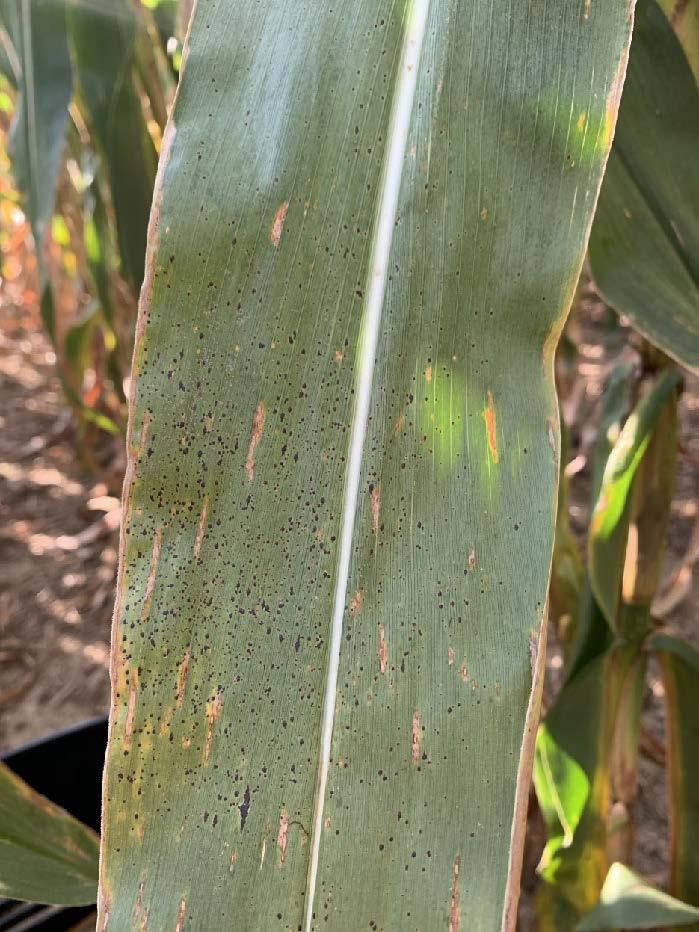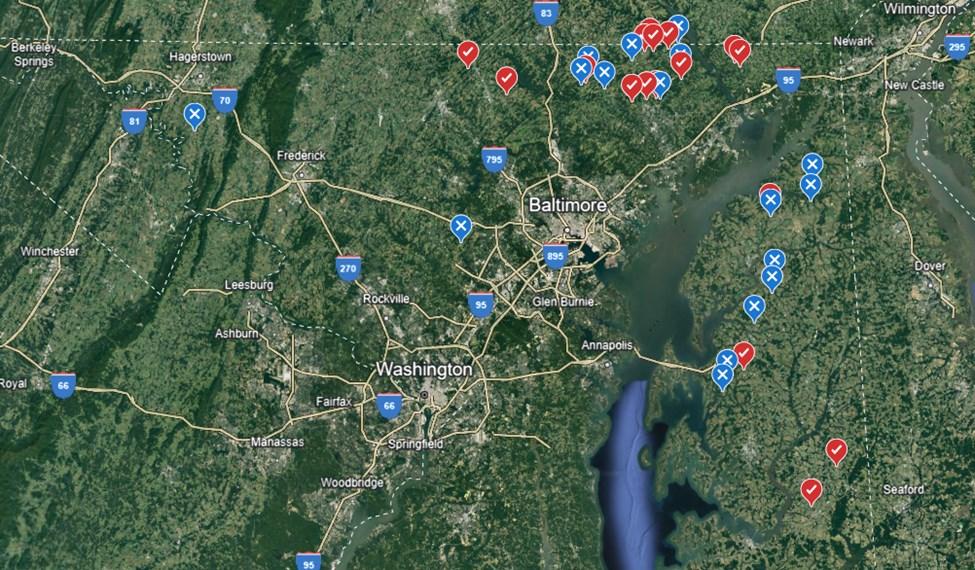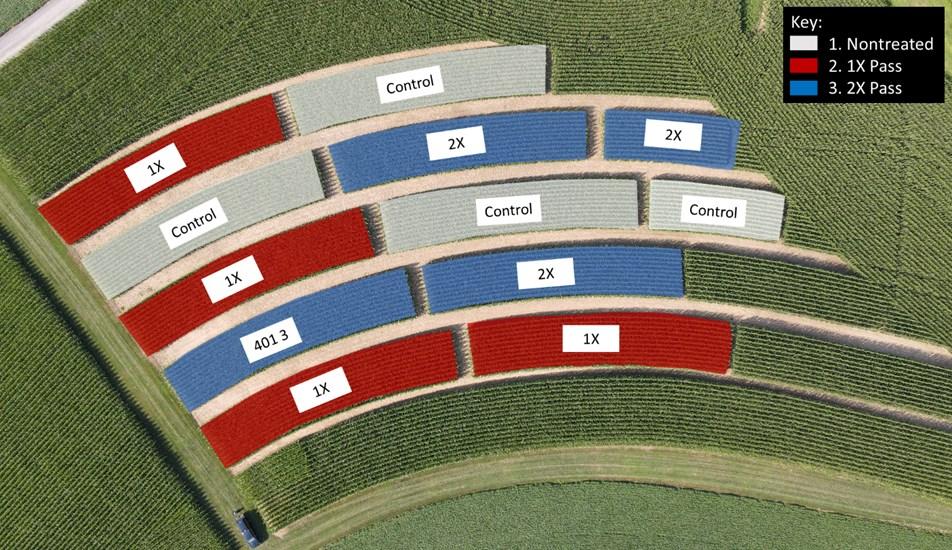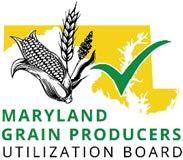
Figure 1. Map showing confirmed distribution of tar spot for the 2023 growing season (yellow). Map from corn.ipmpipe.org.
2023 Maryland Tar Spot of Corn Research
Summary
Tar spot is a new foliar fungal disease of corn first discovered in the United States in 2015 and confirmed in Maryland in 2022 and was estimated to be the most significant yield-limiting disease of corn in the US in 2021 and 2022. As a new disease for our state, this project collected preliminary data on the distribution of tar spot in our state and compared the efficacy of different fungicide application timings. Through field surveys we identified and confirmed tar spot in eight Maryland Counties at a frequency of approximately 47% and at a relatively low severity rate (not exceeding 30%). These observations suggest that the tar spot pathogen can overwinter in Maryland, as it has expanded its range from two counties in 2022 to at least eight in 2023. Field evaluations of two fungicide programs: one pass program at VT and a two-pass program at VT followed by R2, we observed a significant difference in tar spot severity and plant lodging compared to the control; however, there was no difference in yield. Additional research on fungicide timing and the spread of this disease should be conducted in the future to help develop improved management recommendations.
Survey of Tar Spot Distribution in Maryland

Several fields were scouted for tar spot starting during late vegetative growth stages and frequency and intensity of scouting was increased from tassel through harvest. Initial scouting was focused in fields in Harford County near fields where tar spot was confirmed in 2022. In addition, reports were solicited from other Extension Agents and crop consultants/scouts throughout the state. Suspected positive samples were confirmed by laboratory technique and all positive samples were uploaded to the tar spot tracker map on corn.ipmpipe.org.
The first reported and confirmed incidence of tar spot in Maryland for 2023 came from a corn field in Cecil County on August 22. The second came from Carroll County on August 31, followed by Harford County on September 3. We confirmed tar spot in the additional counties of Kent and Queen Anne’s on September 19; Baltimore County on September 22; Caroline County on September 25, and Dorchester County on October 6 (Figure 1).
Several fields were scouted in Northern Harford County throughout the year surrounding fields where tar spot was confirmed in 2022. By the end of the season, tar spot was found in over 50% of these fields (9/16) at levels ranging from 2% to 25% severity (Figure 2). It was observed that tar spot severity continued to increase after black layer for as long as there was green, living tissue remaining on the plants. This increase in severity after physiological maturity does not affect yield but does make for a notably increased level of severity present at harvest and thus the potential for an increase in overwintering spores that will provide inoculum for the following year.
An additional survey of 12 fields on Maryland’s Eastern Shore from Cecil to Queen Anne’s County was conducted on September 19. During this time, two fields were confirmed with tar spot. Severity was very low (<2%) in the field in Queen Anne’s County, and high in the field in Kent County (30%).


Altogether, tar spot was confirmed in 16 out of 34 fields (47%) scouted/reported throughout the state (Figure 3), with samples coming from as far west as Washington County (no confirmed samples) east to Cecil County (two confirmed samples) and south on the Maryland Eastern Shore as far as Dorchester County (one sample confirmed).
Weather conditions were favorable for tar spot on the Eastern Shore and Northern Maryland; however, severe drought conditions from Frederick County west may have prevented its widespread establishment in Western Maryland.
Based on this survey, tar spot appears to be established in all the northern counties east of Frederick and south on the Eastern shore to at least Dorchester County, at a frequency of approximately 40-50%. Judging by the confirmed occurrences in other counties in different states, it is likely that tar spot is present in more Maryland Counties than determined by this survey.
On-Farm Fungicide Trials
Fungicides are an effective management tool for foliar diseases of corn, including tar spot. Research from the Midwest has shown a positive response to fungicide applications in fields where tar spot disease severity is high. However, there is debate as to if one fungicide application made around VT is sufficient to control tar spot, as yield losses have been reported as late as R4. In 2023 we established an on-farm trial to evaluate the response to a single fungicide application compared to a two-pass program for managing tar spot in corn.

Field plots were established at a farm in Harford County, MD in a field immediately adjacent to where tar spot was found in 2022. Corn (Revere Seed ‘1307 TCRIB’) was no-till planted into soybean residue with a John Deere 1775 NT ExactEmerge™, 30-inch, 16 row planter at the rate of 35,000 seeds/acre. Rows 1, 2, 15, and 16 on the planter were shut off to create alleys between adjacent plots and to eliminate treatment overlap, as well as to ensure harvest accuracy. This resulted in 12-row plots that were between 75 and 150 feet long. Plots were arranged in the field in a randomized block with three treatments and five replicates (Figure 4).
Fungicides (Table 1) were applied at the VT and R2 growth stages using a DJI T30 drone calibrated to deliver 2.8 gallons per acre spray volume to the entire length of the 12-row plots. VT applications were made on July 12 and R2 applications were made on August 5. Trivapro 2.1 SE was used for all applications. Trivapro was selected because previous research has demonstrated that multi-mode-of-action products have the best efficacy against tar spot.
| Treatment | Product Name Active Ingredient(s) |
Application Rate (& Timing) |
|---|---|---|
| Nontreated Control | N/A | N/A |
| 1X Pass | Trivapro 2.1 SE Benzovindiflupyr + Azoxystrobin + Propiconazole |
13.7 fl oz/A (VT) |
| 2X Pass | Trivapro 2.1 SE Benzovindiflupyr + Azoxystrobin + Propiconazole |
13.7 fl oz/A (VT) & 13.7 fl oz/A (R2) |
Foliar diseases were rated prior to fungicide application and approximately every two to three weeks following until harvest. Disease severity from tar spot was visually rated as the percent leaf area infected in the canopy from 10 random plants from the center two rows of each plot.
Lodging scores were collected at harvest by conducting a “push test” on 10 plants from the center two rows of each plot. The push test consists of pushing a corn plant approximately 30 degrees from vertical; plants that break have compromised stalk strength and were considered lodged.
Yield data were collected by harvesting 12 rows of each plot using a John Deere S780 combine on October 13, 2023. Yield data was exported from the combine monitor and RTK was used to correlate yield with plot locations since we were not able to collect individual plot weights. All yields reported are adjusted to 15.5% moisture. All data were analyzed using ANOVA and significant differences between treatments were separated using Fisher’s Least Significant Difference (LSD; α=0.10).
On-Farm Trial Results
Tar spot was first observed in the plots on August 29 present at a very low level (less than 2% severity). Overall tar spot disease severity was low throughout the season in these plots. One possible explanation for this is the early planting date, which likely allowed the corn to complete its critical reproductive growth stages before weather conditions were favorable for tar spot development.
Early disease ratings revealed a significant difference in tar spot severity (P=0.0176) in treated plots vs nontreated plots (Table 2). However, late disease ratings collected at harvest show an overall increase in tar spot severity, but no difference between treated and nontreated plots. This is likely due to the fact that fungicides can only offer around 14-21 days of protection. In this trial, the second fungicide application did not provide improved tar spot control compared to the single pass treatment; however, the single fungicide application at VT delayed tar spot infection compared to the nontreated control.
| Treatment | Tar Spot Severity (%) | Lodged Plants | Grain Yield | Grain Moisture | |
|---|---|---|---|---|---|
| 9/11/23 | 10/12/23 | (%) | (bu/acre) | (%) | |
| Control | 3.05 a* | 3.75 | 10.0 a | 192.56 | 19.06 |
| 1X Pass | 1.18 b | 2.88 | 5.0 a | 199.05 | 19.41 |
| 2X Pass | 0.85 b | 4.00 | 0.0 b | 201.56 | 20.31 |
| p-value | 0.0176 | 0.4133 | 0.0680 | 0.2123 | 0.4343 |
*Treatments connected by the same letter are not significantly different from each other (α=0.10).
The control plots averaged 192.56 bu/acre with a low of 169.7 and high of 214.6; the single pass (1X pass) program yielded an average of 199.05 bu/acre with a low of 177.5 and high of 228.6 bu/acre; and the two-pass (2X pass) fungicide treatment yielded an average of 201.56 bu/acre with a low and high of 194.4 and 222.7 bu/acre, respectively. However, there are no statistically significant differences in yield between treatments (P=0.2123). Likewise, there was also no significant difference in grain moisture. Tar spot disease severity was relatively low; likely too low to impact yield in this trial, leading to no yield response.
The 2X pass fungicide program did improve standability of the crop at harvest, with 0.0% lodging, significantly better than the 1X program (5.0%) and the control (10.0%).

This work was supported by funding through the Maryland Grain Producer’s Utilization Board and in-kind support from The Mill. Special thanks to Clear Meadow Farm for their use of land and equipment making this research possible.
Agronomy News, November 2023, Vol. 14, Issue 8
Agronomy News is a statewide newsletter for farmers, consultants, researchers, and educators interested in grain and row crop forage production systems. This newsletter is published once a month during the growing season and will include topics pertinent to agronomic crop production. Subscribers will receive an email with the latest edition.
Subscribe